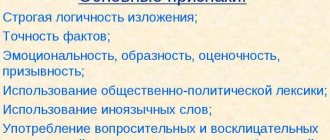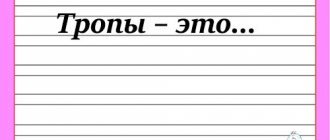A conversational style of speech is on the agenda. If you take and record our everyday conversation, you will most likely get a pun, or, better said, nothing good will come out of this idea at all. Those norms that are applicable for book speech may be completely unsuitable for colloquial speech.
In this article you will learn what a conversational style of speech is, what function it performs, read about the characteristic features, features and genres of a conversational style, and also find examples of this functional style of speech.
Features of construction and application
This style of speech is used for everyday communication in an informal setting, when the author discusses everyday issues with someone, shares impressions, experiences, and feelings.
It is used in family, friendly and informal relationships. But mostly colloquial speech is used in everyday life, so the second name for this style is everyday.
Main features
Communication between people began a very long time ago. Conversation became one of the first forms of communicative interaction. Over the course of many years, the features of the colloquial style developed; it acquired typical features and characteristics:
- Expressiveness. Interlocutors can change the timbre of their voice, tone, volume at their own request and discretion.
- Situational. In this case, speech is tied to the situation and directly depends on it. The specific setting, place and time influence the person speaking, setting the topic, speed and length of communication.
- Spontaneity. The interlocutors do not prepare for the conversation in advance and express their opinions, ideas and thoughts during the conversation. Their speech is random, they think more about the content than the beautiful delivery. Because of this, inaccuracies, negligence, ambiguity and understatement in phonetic, lexical and syntactic terms are acceptable in speech.
- Ease. The speaker is not bound by any obligations, therefore his statements are voluntary, they are not governed by any norms. A person can speak out or remain silent. He is free to change the topic or not answer an objectionable question, which is why communication is informal.
- Use of non-verbal means. Facial expressions and gestures serve as constant companions of the conversational style. They add expression, allow you to express feelings more accurately and vividly, and better convey sensations.
Where is it used?
It may seem that the conversational style has no genres and its use is not limited by anything, but this is not the case. Even in informal speech there is genre diversity, and speech itself is divided into oral and written:
- Conversation. This is the most famous and popular genre of oral speech. Conversations are resorted to in a friendly environment, with family or during acquaintances. This is a simple type of communication in a calm environment, often without a specific goal.
- Story. It is a continuous narrative, a monologue tied to a specific event or subject. The story tells about important details of what happened, interesting moments, gives an assessment, and describes impressions.
- Dispute. This oral genre serves to defend and defend one's point of view in a relaxed atmosphere.
- Letter. This is a genre of writing in which people share their emotions, explain something, or establish contact in a free form. In this case, the rule of greeting and farewell in the text is usually followed.
- A note. The genre is short and also refers to the written form of communication. It is shorter than a letter and serves to convey one information message. Usually this is how people invite each other somewhere, warn each other about something.
- Diary. In this case, there is a dialogue between the author and himself, which takes on a written form. Diary entries are distinguished by their frankness. Some people write down some creative work there: poems, notes, essays.
READ Interesting questions to help spark conversation
Types of speech
Speech type is a way of presenting information, constructing words and sentences in a logical order.
There are three types of speech:
- narration;
- description;
- reasoning.
Let's consider the features of each type of speech.
Narration
A story about an event or phenomenon. Main features:
- associated with a period of time;
- has a certain sequence of actions;
- consistency of presentation;
- the text answers the questions “what”, “where”, “when”;
- a large number of verbs.
As a result of the narration, the reader becomes clear what happened, where and with whom. The narrative is characterized by the beginning, development and denouement of events. Used in letters, memoirs, memoirs, diary entries.
Description
The purpose of the description is to verbally convey the phenomenon, talk about the qualities of the object, signs, and create a visual or sensory image in the reader. You can describe people, animals, a certain place, event, phenomenon, the internal state of a person and any other phenomenon.
Comprises:
- general characteristics of the subject, general impression;
- signs, details;
- overall assessment of the subject.
Speech is dominated by adjectives, adverbs, and nouns. A minimum of verbs, unlike the narrative, the text is static. Can be used in various styles of speech, most often in artistic and scientific ones. In the latter, accuracy and detail are important, in the artistic - the creation of a certain image in front of the reader, only the most striking moments are described.
Reasoning
Reasoning is thinking, expressing thoughts and ideas, explaining phenomena and properties of an object. The text provides answers to the questions “why” and “why”.
Comprises:
- thesis - an idea that needs to be proven;
- substantiation of the thesis, supporting arguments with examples, evidence;
- summary - results, conclusions.
The purpose of the text is to convince, explain, prove. Reasoning is characterized by rhetorical questions, a sequence of thoughts - “firstly”, “secondly”, “thirdly”, introductory constructions - “meanwhile”, “thus”, “so”, “because”, “ hence".
Often found in scientific and fiction literature, philosophical treatises.
Syntactic features
Colloquial speech has clear distinctive stylistic features in terms of construction and types of sentences.
Most often, everyday style consists of simple sentences without conjunctions and complex constructions. You will not find participles or gerunds in them, but there may be homogeneous members and enumerations.
Due to the bright emotional coloring, the use of exclamatory and interrogative sentences, as well as monosyllabic and one-word sentences, which express assessment, denial, affirmation, motivation, bewilderment, is common.
Often the proposal is disrupted by additional structures. They perform a clarifying function, serve as a comment or correction. There are also introductory words and phrases with different meanings.
There are pauses in the speaker’s speech, for example, due to excitement. Sentences may not be connected in meaning due to a sudden change of topic or “flight of thought”.
Word formation
But colloquial vocabulary is replenished not only thanks to new expressions or new figurative meanings. Often old words from book speech easily turn into colloquial ones due to various ways of merging phrases: sliders, homeless child, microwave, smoking room, mobile phone; abbreviations: IMHO (I have an opinion, I want to voice it), BUR (high security barracks); and morphemic units:
- Suffix -yag - tramp, goner, dude, hard worker.
- The suffix -ezh- clamor, whining, cramming.
- Confix slowly, little by little.
- Suffix -ish- bag, tooth, cat.
- Various diminutive suffixes -k-, -ek-, -ik-, -ok- son, fungus, baby.
Morphological features
The form, structure and frequency of use of words in colloquial speech often contradict the rules of the Russian language. But this makes the style of everyday communication unique and recognizable:
- There is a tendency not to decline the first name in combination with the surname (Semyon Semenychu), some numerals (from two hundred and forty-eight). On the contrary, indeclinable abbreviations and abbreviated names are declined (in the registry office).
- Possessive adjectives are popular (Sashka’s girlfriend, fireman’s wife).
- The primacy of verbs over nouns. Frequent use of particles and verbal interjections (boom, jump, grab).
- Nouns are used in the genitive or prepositional case ending in -u (in the workshop, give me some tea, back from vacation).
- Verb tenses are blurred. Past and future tenses are used to mean the present.
- A large number of personal and demonstrative pronouns.
- The use of imperative interjections to fully convey the feelings experienced.
- Repeating certain words to create emphasis.
- Using inversion to enhance the meaning of a particular word.
Linguistic features of everyday language
Features of the conversational style of speech lie primarily in pronunciation. Often people put the wrong emphasis, which is unacceptable for more rigorous texts, for example, written in a scientific style.
Lexical features
Lexical features in colloquial speech indicate the ease of communication and its expressive flavor. During a conversation, people often change words in one part or another, for example, they say angry, smart, wise, sarcastic, jabber, bother, quietly, little by little, well, and so on.
In everyday speech, phraseological units are often used, because a person has a dominant way of thinking in everyday communication. Observing some phenomenon, he makes a generalization. Examples: “There is no smoke without fire”, “The grave will straighten the hunchback”, “Slower than water, lower than the grass” and so on.
The linguistic features of the conversational style also lie in the fact that this style of text has its own word formation. Nouns often change their suffixes, for example, good man, old man, huckster, reveler, feeder, and so on.
A conversational style text may also contain words that designate feminine persons by their specialty, position, occupation, for example, director, secretary, doctor. In addition, there are suffixes of subjective assessment, thanks to which the message acquires the greatest color, for example, thief, naughty girl, little house, feisty and others.
Colloquial adjectives can also change their suffixes like this: big-eyed, big-tongued. In addition, people often apply the prefix “pre” to adjectives, resulting in pre-kind, pre-nice, pre-unpleasant, and so on. Verbs that speak about everyday speech look like this: to misbehave, to wander, to cheat.
Morphological features
Morphological features of the colloquial style of speech imply the use of parts of speech in the wrong case. For example, nouns in the prepositional case: he is on vacation, a plural noun in the nominative or genitive case: agreements, not contracts, several tomatoes, not tomatoes, and so on.
Lexical means
Of course, colloquial speech has the most striking differences due to the abundance of special words in it, which are acceptable and appropriate only here. The linguistic palette of everyday style is bright and varied due to its richness in emotions. Often, familiar literary and artistic means and techniques are not enough to express the full range of feelings:
- Wide use of stress, intonation, changes in timbre and rhythm of the voice to add additional color to speech.
- An abundance of colloquial vocabulary, vernacular, jargon, vulgarisms (right now, hot, hard worker, minibus, mobile, cash).
READ Abusive relationships: toxic relationships under the guise of normality
- Frequent phraseological phrases that are in the nature of evaluative generalizations (the hunchbacked grave will correct), the use of words in a figurative meaning (window - break, hat - mistake).
- The merging of a word with its meaning or assessment, when it is clear without additional explanation (opener, trickster, good fellow, smart guy).
- The use of words with diminutive or augmentative suffixes (blushing, pretty, little book, little chair).
- Simplification and shortening of long words or names (grade book - grade book). Borrowing foreign language vocabulary (lol, fake, hype). Addition of words (slow-witted, parasite).
- Multi-prefixed verbs with expressive coloring (hold up, don't get enough sleep, throw away).
Vernacular
This group of words and expressions does not fit into the norms and framework of literary speech. It carries shades of simplification, rudeness, and reduction of meaning.
Some scientists distinguish vernaculars into a separate lower layer of vocabulary, since they are used by people to convey a special attitude towards a subject or object, that is, they act as a full-fledged stylistic linguistic unit. The second group of researchers classifies vernaculars as a special group that goes beyond the literary language.
The use of colloquial words is deliberate when it is included in the narrative by educated people in order to give the story a special tone, specific coloring, and imagery. This is what publicists, journalists, speakers, and politicians do. In addition, this is found everywhere in the everyday speech of the average city resident. But even those deprived of education can use vernaculars. This situation is already deliberate in nature, when there is not enough intelligence and vocabulary to express thoughts differently.
Colloquial speeches are quickly remembered due to their vivid meanings. They are individual, often do not have synonyms, related or cognate words.
Jargonisms
In modern Russian, there are three groups of slang words: youth slang, professional slang (among workers' organizations - construction workers, factory workers, truck drivers) and camp or prison slang (it is used in prisons).
READ How to become sociable: effective practices and recommendations from a psychologist
Slang is most widespread in everyday speech. The sources of its occurrence are considered to be student communities, schools, and gymnasiums. Its appearance is associated with the desire of young people to stand out and be different from those around them. All slang words have synonyms in the literary language (dormitory - hostel, correspondence - distance learning, kurach - course work, teacher - teacher). Jargon also includes words that convey the attitude or state of the speaker (high, awesome, laugh, labor, cool).
Vulgarisms
These are the most brightly colored words allowed in speech. Vulgarisms are rude, aggressive or even vulgar in nature. They are far beyond the boundaries of literary language, but their use is sometimes acceptable as an additional artistic device.
Vulgarisms include all curses, abusive expressions, words that convey strong negative emotions, taboo words and blasphemy (die - die, lupals - eyes, eat - eat, muzzle - face).
The presence of a large number of vulgarisms in speech indicates a low culture of behavior, lack of education and spirituality.
What is colloquial and colloquial vocabulary? Examples of colloquial words
Conversational style vocabulary includes words that give speech a free character. In comparison with the literary language, it is considered stylistically reduced.
Colloquial vocabulary is words with a stylistically reduced connotation.
Examples of colloquial and colloquial words: sonny, stupid, tipok, grandma, nix, crybaby, daughter, stipukha, dorm, trash, blooper, dog, mug, here, muzzle, stupid, Svenovsky, shipper, staging, grandma, nonsense, carrion, like, gopnik, reptile, dyke, butch.
Style examples
Spoken speech can be heard everywhere every day. This is a way of informal communication for most.
An example from everyday communication between friends
- How was your weekend?
- Great! Laces went to the dacha to work as a farmhand on potatoes. And we got together with the boys, first we hung out at home, then we went for a walk in the park. It's a shame you weren't there. Why didn't you come to me?
— The course student wrote, otherwise it was due on Monday, and I didn’t even have half of it. I've been fussing over him all weekend. Thank God, I passed it calmly! Now you can have fun!
An example from Russian literature
The work of A.P. Chekhov “Revenge”.
- Open it, damn it! How long will I have to remain numb in this through wind? If you knew that it was twenty degrees below zero in your corridor, you wouldn’t have made me wait so long! Or maybe you don't have a heart?
Conversational style ad
Hello! You are reading this, which means you are looking for a job. Isn't that right, buddy? We suggest you slow down and get acquainted with our offer. Why come to us? Keep your fingers crossed: money, girls, the opportunity to create your own fan club, room for creativity and experimentation, your own powerful piece of hardware with a 25-inch screen. There will be no time to be bored - we promise! Don't wait, click the "Apply" button right now!
The meaning of colloquialism in literature
The authors will often use everyday expressions to make the dialogue sound more authentic.
For example, a contemporary novel author would probably choose the greeting "Hey, how are you doing" rather than "Good afternoon."
They can also use this structure to situate the writing more decisively in a specific time period and/or place. Conversational speech allows you to do this.
When used improperly, everyday expressions often become unpleasant for the reader. In fact, authors should avoid excessive use of dialect, such as distorting words for the purpose of shortening (“now” - “right now”) in colloquial culture.
However, when used correctly, readers can feel trust in the author. Writers may also unconsciously use colloquialisms if they are not accustomed to business mannerisms. The stylistic features of the conversational style will be discussed below.
Style features
The colloquial style of the Russian language is characterized by the following stylistic features:
- ease, informality;
- expressiveness
- lack of preparation
- free choice of language means;
- use of non-verbal means of communication (facial expressions, gestures, reaction of the interlocutor).
Unlike journalism, science, and the official business sphere, in casual communication the speaker does not carefully select linguistic means, but freely uses the entire range of words, figures of speech, and phraseological combinations known to him and in demand immediately at the moment of speech.










